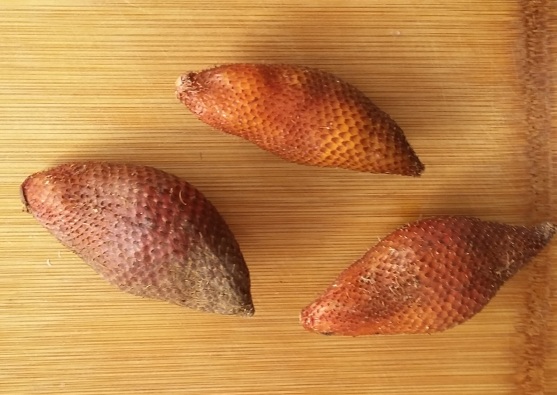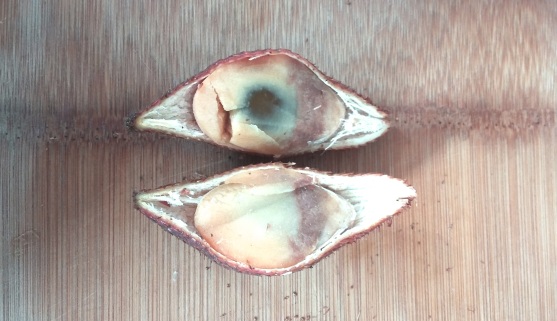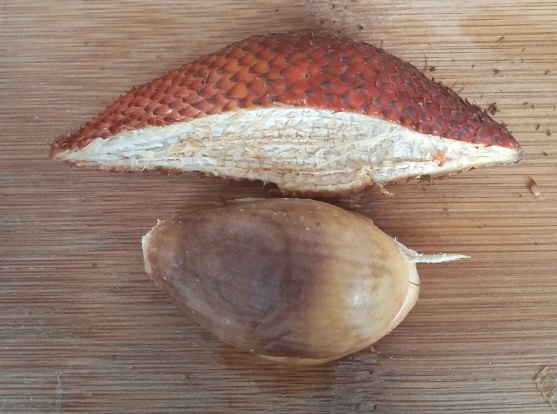Name: Snake fruit, also known as salak.
Appearance: Snake fruit gets its name from its rough, scaly skin, which is covered in soft prickles. That’s right: this fruit has scales – don’t pretend your stomach isn’t rumbling already. While not exactly ovoid in profile, snake fruit is still close enough in shape to resemble the dragon eggs of legend.
One does not usually attempt to eat fruit that looks like it has been freshly birthed from a cold, reptilian womb, so it is with some trepidation that I gingerly slit my snake fruit with a small paring knife. The coarse exterior falls away immediately, leaving the pale lobes of the foetus – sorry, fruit – behind. Yum.
Where do they eat it? Snake fruit grows at the base of salak palm trees, in the wombs of serpents, and in the bowels of hell. It is mainly eaten in Indonesia, particularly in its native Java and Sumatra.
Cost and sourcing: My six snake fruit set me back by 4 dirhams and 80 fils, and came from the Lulu in Mushrif Mall.
So, what does it taste like? A sense of deep, carnal foreboding – already roused when I felt the fruit’s coarse exterior – only intensifies once I’ve sliced the snake fruit in half. I make the mistake of inhaling one of the cut halves, and fight back a retch: I’m instantly reminded of durian fruit, which I sampled in Sri Lanka in July. For the uninitiated, durian fruit smells of sickly-sweet putrefaction, like a seal carcass decomposing on a sea shore. Its soft, slimy texture, reminiscent of a rotten garlic clove, only reinforces this unfortunate comparison with decaying flesh. (This is a strictly personal perspective, by the way – durian fruit is enjoyed across Asia, and certainly my Sri Lankan driver seemed entirely bemused by my reaction to its strong taste).
I swore that I would never eat durian fruit again, but having stumbled across one of its milder cousins I’m being forced to rapidly reassess such strongly-held values. Experimentation and a willingness to try anything once are the values at the heart of this blog, after all, so I dig around inside myself for my brusque Northern English practicality, cut off a small piece of snake fruit flesh, and place it warily in my mouth.
This moment of stoicism pays off: after a few seconds of eyes-screwed-shut, reluctant chewing, I’m surprised to discover that snake fruit doesn’t taste quite as vile as appearances had suggested. With its tart juices, firm texture and slightly sweet aftertaste, it reminds me a little of a nectarine, or perhaps an unripe mango. A slight hint of the putrefaction that so repulsed me earlier, however, never quite leaves the party.
Preparation: To prepare your snake fruit, slice it in half and remove the outer skin. The fruit should contain a stone or pip – discard this before eating.
Verdict: 2/5
My previous traumatic experience with durian fruit tainted this week’s taste-test with its scaly sister, but not fatally so. While I would never describe snake fruit as “delicious”, “delectable” or “delightful”, I can easily imagine its distinctly tropical flavour appealing to those with more adventurous palates. It certainly has a place in a fruit salad – try pairing it with fruits such as banana or melon, whose blander flavours and more pleasing aromas should cut through the tartness nicely.




One thought on “Weird vegetable #2: Snake fruit”